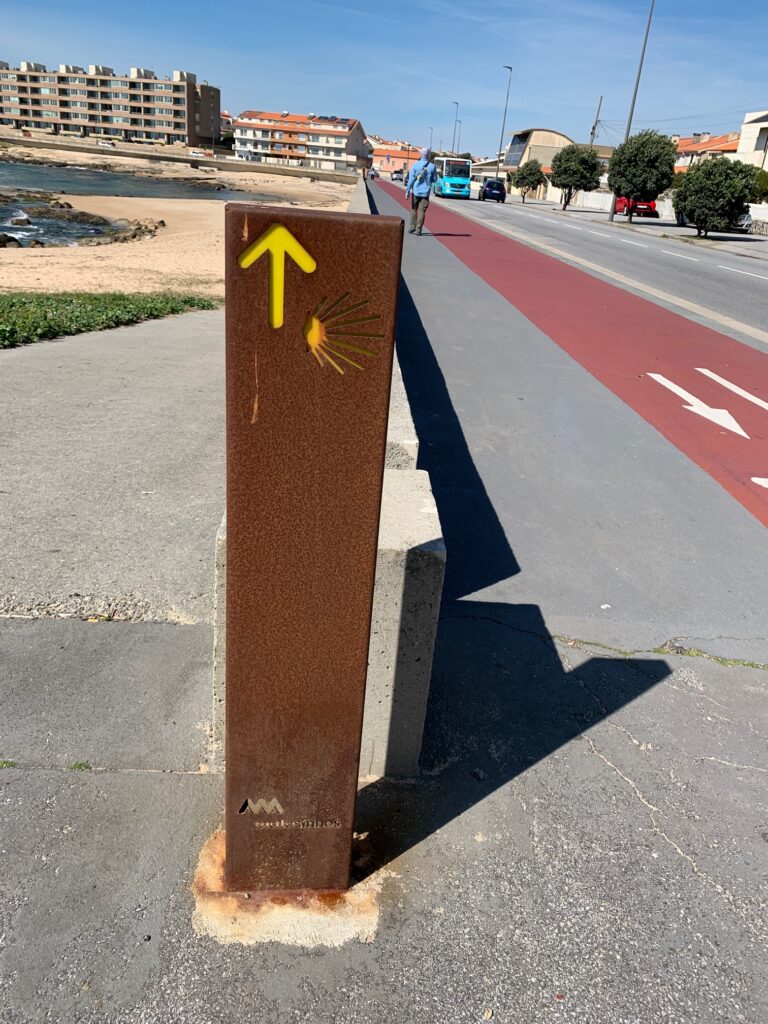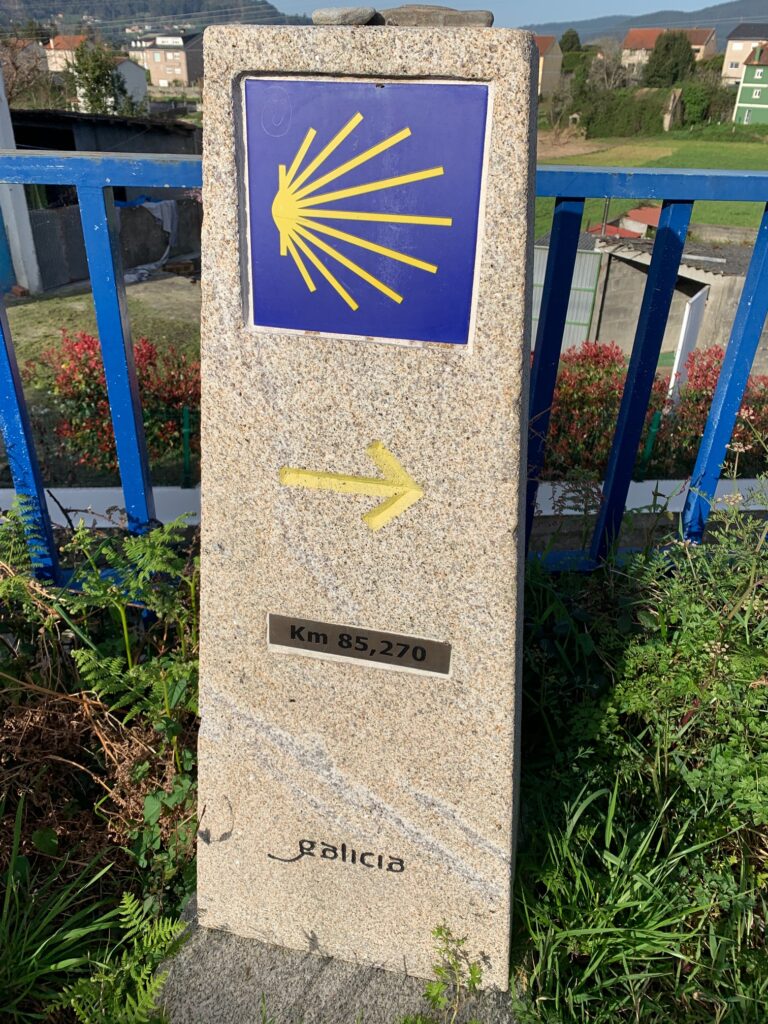

The Camino Portugues Coastal Route is one of three routes between Porto, Portugal and Santiago de Compostela, Spain. We completed the coastal route in late March 2023 and the weather was perfect for walking. It was cool but not cold. Sometimes it was T-shirt weather when the sun was out.
The coastal route was very enjoyable. The Atlantic Ocean was always on our left for almost two thirds of the way. The path included boardwalks, pedestrian only paths, some cobbled streets, hiking trails, some street sidewalks and sometimes on the beach. The scenery varied a lot and the ocean breeze was a welcome relief before the path turned inland north of Vigo, Spain. The only drawback of the coastal route was that establishments such as “mercados”, “paderias”, restaurants and accommodations were spread out. But that was only south of Bainoa, Spain and was not a problem in our experience. We just ate a heavy breakfast and snacked our way through lunch before reaching our night’s accommodation and dinner.
Distance
The official distance, meaning the distance that appears on the certificate issued at Santiago de Compostela is 280 kilometers (173 miles). To us, the total distance was irrelevant. What was relevant was the distance covered each day. It took us a total of 12 walking days covering between 16 and 30 kilometers (10 to 18 miles) per day.
In hindsight, we could have shortened the daily distance covered for the first few days to allow our bodies to get used to the long walk while carrying a backpack.
What We Carried
We left most of our “travel stuff” at our hotel’s luggage storage room in Porto as we returned to this city after our camino. Me and my wife each packed the following, aside from what we wore on our first day of walking.
- Folding umbrella and packable rain jacket,
- A spare t-shirt and underwear and a pair of shorts,
- A hooded long-sleeve shirt, a mid-weight upper and lower base layers, and a long sleeve UFP polo shirt,
- Toiletries, lightweight pair of slippers and a string line with mini-clothes pins for drying our clothes, and
- Electronic gadgets and a water bottle.
All our camino stuff were able to fit in a 20 liter backpack and a 6 liter sling bag that I made. We even brought our laptop and a tablet. The base layers were not needed for the camino but we needed it for our trip after the camino before returning to Porto.
Most peregrinos commented that we packed light. We saw a lot of peregrinos carrying 40 to 60 liter backpacks. Perhaps because they stayed at albergues, where they had to bring a sleeping bag and a towel because linens and towels were not provided, according to a few peregrinos that we talked to.
There was a couple of peregrinos from Finland that commented that perhaps they should have done the same thing which was staying in guest houses, apartments and hotels instead of albuergues. There were people that we talked to that utilized luggage transfer services that had their luggage transported to their accommodations throughout the journey.
To us, trimming down what we needed to carry was the right decision. It was easier on the body overall.
Where We Stayed
We stayed in guest houses with private rooms, hotels and apartments. This allowed us to pack light because we could wash and dry our clothes every night. All the accommodations we stayed in had hair dryers so we could always dry our clothes the following morning if it did not dry on the clothesline overnight. Some of our accommodations have the heated towel rack. We used these as our dryer and was very convenient.
The downsides of staying in places other than albuerges are:
- We had to book in advance,
- Our schedule was not flexible, meaning we had to get to our night’s accommodation (I imagine this would also be the case for those that utilize the luggage transfer service).
- It costs more.
In hindsight, because we went during the off-season, most accommodations were not fully booked. We probably (emphasize “probably”) could have gotten away with booking accommodations as we went, which would have been nice if we needed to stay more than one day in a place to relax, recover if we got sick or if the weather turned bad (we both actually wrestled with a persistent cold for almost the entire trip). However, this would only be possible if we had Wifi as our international phone plan has a limited amount of data.
See Camino Portugues Coastal Route Accommodations for descriptions of where we stayed.
Distances and Walking Times
The distances shown in Part 2 are based on Google Maps but guess-adjusted based on the actual route as Google Maps walking route directed us to take streets and highways instead of the actual camino route. The times shown are actual times from start to finish including short breaks. There was only one leg where we ate lunch which was at A Guarda, Spain.
A word of caution. Do not rely on Google Maps for walking times unless you are a fast walker. We found that it took us one to two hours longer than what Google Maps showed. However, we needed Google Maps (or similar navigation apps) to check our location and direction in cases where we have not seen a camino sign for a while.
Prior to our camino, we did 5 miles (8 kilometers) to 8 miles (13 kilometers) practice walks around our neighborhood. However, we just walked and did not carry a weighted backpack. Our practice walk pace was in-line with what Google Maps showed which was about 3 miles per hour (4.8 kilometers per hour). However, we found that we considerably slow down to between 3.5 to 4 kilometers an hour on the camino. We figure that the longer walk, coupled with doing it everyday with a weighted backpack took its toll and slowed us down.
Camino Signs
Camino signs direct peregrinos where to go. We saw our first Camino Portugues Coastal route sign at the city of Matosinhos, Portugal.
In Portugal, the signs were a combination of yellow arrows on blue tiles with the camino shell, rusted metal signs or just painted yellow arrows on lamp posts, walls or other permanent structures. These signs are few and far in between. We had to always look around to make sure we did not miss the signs.


Some signs would direct us to go inland which was counter intuitive as it moved away from the coast. This was especially true between the cities of Esponsende and Viana do Castelo. I got lost after getting to the end of the boardwalk at the south end of Ecovia Litoral Norte which is a park north of Esposende (more in Part 2).
Past A Guarda, Spain, the signs were stand alone waist high monuments that have the shell symbol, direction arrow and the remaining kilometers to Santiago de Compostela. Whether those remaining kilometers are accurate or not is another matter but at least it told us when we needed to get two stamps per day (beginning at 100 kms remaining).
We referred to these monuments as the Galicia signs. The Galicia signs were also often, sometimes too often in little towns, villages, forest and along farmer’s fields. However, there were some stretches where the Galicia signs were not present that made us take a pause to check our bearings. This was especially true between Baiona and Vigo, Spain where the markers were mainly painted arrows, in the industrial area of Vigo where we did not see a sign whatsover, and at Santiago de Compostela where the Galicai signs sort of disappeared in the last three kilometers.


Camino passport and pilgrim shell
The camino passport or credential is used to collect the stamps. One stamp a day is required before Vigo, Spain. Two stamps per day is required after Vigo. We presented our stamped passports at the Santiago de Compostela Pilgrim Office to get our completion certificates.
We obtained our passports from the Porto Cathedral Office. Entry to the office is via separate door to the right of the cathedral’s double entry doors. We paid 2 Euros for a passport. Unfortunately, we did not take notes of the office’s hours but we got our passports on a Saturday afternoon.
Pilgrim shells let others know that the bearer is a pilgrim. It is cool to have and hang on the backpack but not necessary. We were greeted “bom camino” (Portuguese) or “buen camino” (Spanish) despite our shells were on our back and not readily visible. Most locals assume that a person with a backpack walking the route is a pilgrim. Same way with other pilgrims. We tend to run into the same group of people for three or four days on the trail.
We got our pilgrim shell from a local shop along the route that offered to stamp our passport. We actually overpaid for it for being too zealous to have one (4 Euros each). Pilgrim shells were sold at the Pilgrim Office in Santiago de Compostela at a more reasonable price. There were also other souvenirs available at the Pilgrim Office and at several stores in the city.


Summary
The Camino Portugues Coastal Route from Porto was a wonderful way to experience the “walk”. It is short compared to other routes like the Camino Frances or Camino del Norte. There was something magical doing this pilgrimage with the ocean on our left shoulder for almost two thirds of the journey.
We were glad to do this camino during the second half of March. At first, we were concerned about the weather as it was cloudy and cold in Porto when we arrived the day before our walk. As it turned out, we only got rained once in the 13 days we were on the trail. To us, getting soaked once was a better option than walking in the heat had we done the camino in the summer when it is peak season. We hope that our three part write-up about the Camino Portugues Coastal Route from Porto will help you plan your own camino.
